As boat traffic ebbs, we can enjoy the peace, quiet & beauty of the River. September was a month to relish. Almost every day was calm and graceful. What a perfect time to start a Sudoku puzzle with a cup of coffee in hand! PUZZLE #30
DAN’S 8 STEP APPROACH TO SOLVING ALL SUDOKU PUZZLES Once you have completed the puzzle, to the extent that you have filled in all obvious answers and have written all potential options across the top of the unsolved cells (PUZZLE PREPARATION), Dan recommends the following Steps to complete the puzzle. See TI Life Puzzle Preparation: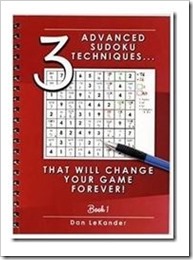 Step 1: Sudoku Pairs, Triplets and Quads – September 2015 Step 2: Turbos & Interaction – October 2015 Step 3: Sudoku Gordonian Rectangles and Polygons – November 2015 Step 4: XY-Wings & XYZ Wings – December 2015 Step 5: X-Wings – January 2016 ________________ Step 6: DAN’S YES/NO CHALLENGE Step 7: DAN’S CLOSE RELATIONSHIP CHALLENGE Step 8: AN EXPANSION OF STEP 7 Steps 1-5 are relatively common techniques and are explained in the TI LIFE articles per above. Steps 6-8 are covered in detail, in Dan’s book. Also, see Sudoku Puzzle Challenge… February 2016, Sudoku Puzzle Challenge–March 2016, Sudoku Puzzle Challenge–April 2016, May 2016, June 2016, July 2016, August 2016, September 2016, October 2016, November 2016, December 2016, January 2017, February 2017, March 2017 , April 2017, May 2017, June 2017, July 2017, August 2017 and September 2017. As a reminder, the basic rules of Sudoku are that the numbers 1-9 must be contained and cannot be repeated in a row, column, or box, and there can only be one solution to the puzzle. |
This puzzle may be intimidating at first sight. My suggestion is to print this page and give it a go. Follow the 8-steps to solving any Sudoku puzzle.
If you would prefer to follow along the path to completion, be my guest …
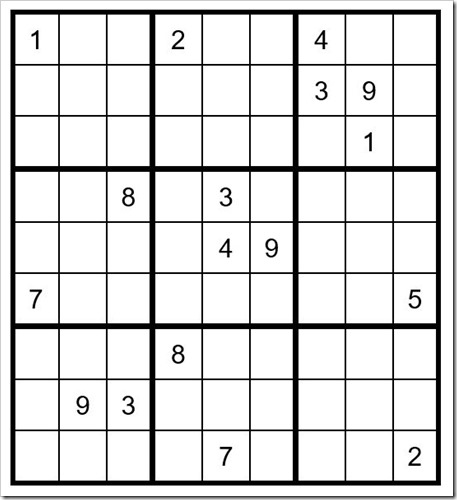
Puzzle #30 |
PUZZLE PREPARATION
Prior to utilizing techniques first complete the 4 Steps of Puzzle Preparation …
1. FILL IN OBVIOUS ANSWERS
2. FILL IN NOT-SO-OBVIOUS ANSWERS
3. MARK UNSOLVED CELLS WITH OPTIONS THAT CANNOT EXIST IN THOSE CELLS
4. FILL IN THE OPTIONS FOR THE UNSOLVED CELLS
OBVIOUS ANSWERS … Start with the 1’s to see if there are any obvious 1-choice answers. Then navigate the 2’s through 9’s.
The first obvious answer is C7R3 (cell in column 7, row 3) =2. C8R1=5.
NOT-SO-OBVIOUS ANSWERS … none.
NUMBERS IN CELLS THAT CANNOT EXIST …
In box 3 (middle center grid of 3 x 3 cells) an 8 can exist only in cells C5R6 or C6R6; therefore, an 8 cannot exist in C7R6 or C8R6. On your grid, mark the bottom of these two cells with an “8”, indicating that an 8 cannot be an option.
In box 7 a 7 can only exist in cells C2R7 or C3R7; therefore, a 7 cannot exist in C7R7, C8R7 & C9R7.
In box 3 the only choice for C9R1, C9R2 & C9R3 are options 6, 7 & 8 forming an obvious triplet; therefore, options 6, 7 & 8 cannot exist in the other cells in column 9.
FILL IN THE OPTIONS FOR THE UNSOLVED CELLS … after considering the options that cannot exist, your grid should now look like Example #30.1 below:
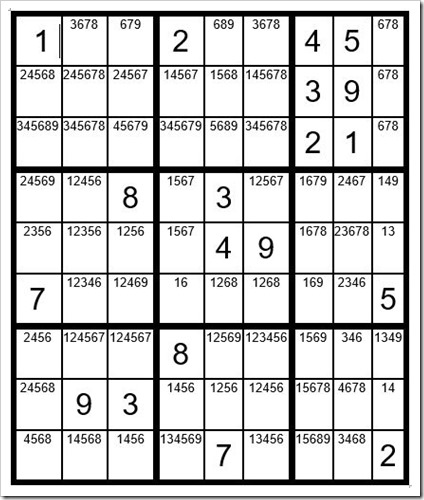
Example #30.1 |
STEPS 1-8 …
STEP 1 … PAIRS, TRIPLETS & QUADS
Examine column 4 carefully. The only two cells that contain the options 3 & 9 are C4R3 & C4R9. Therefore; this is an identification of a hidden pair. You may eliminate all other options from these 2 cells. Now your grid should look like Example #30.2 below:
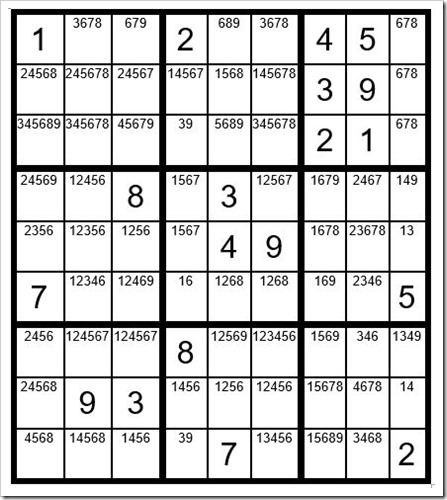
Example #30.2 |
There are no other Step 1-5 clues. We should hope that Steps 6-8 will produce a clue!
STEP 6 … DAN’S YES-NO CHALLENGE
There are 3 circumstances that establish the potential for a Step 6 exercise:
1. Look for just 2 unsolved cells in a box that contain the same option where these 2 cells are not in the same row or column.
2. Look for just 2 unsolved cells in a column that contain the same option where these 2 cells are not in the same box.
3. Look for just 2 unsolved cells in a row that contain the same option where these 2 cells are not in the same box.
In column 1 we find just 2 unsolved cells that contain #3 as an option … C1R3 & C1R5. These cells are not in the same box, thereby qualifying as a candidate for a Step 6 exercise. These cells are highlighted below in Example #30.3
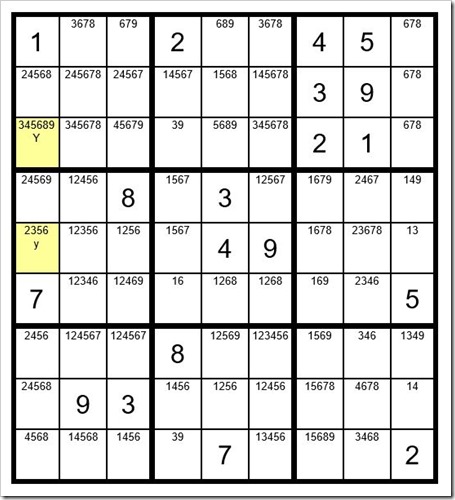
Example #30.3 |
One of these two cells must be a 3. We will consider them as “starter cells” which “drive” the exercise.
Here is the theory. We will perform two exercises. First, we will assume C1R3 is the 3, and see which other cells cannot be a 3. Then we will assume C1R5 is the 3, and see which other cells cannot be a 3. What happens if we find a cell or cells that cannot be a 3 regardless of which cell in column 1 is a 3? Quite simply it means that that cell cannot be a 3 and you can eliminate the 3 from that cell or those cells.
We will mark C1R3 with a “Y” and mark C1R5 with a lower case “y” to keep track of the exercise as per Example #30.3 above.
Starting with C1R3 we see that if it is a 3 (Y for yes), then C4R3 & C6R3 are not a 3. We will mark these two cells with a “N” indicating they cannot be a 3 if C1R3 is a 3 (see Example #30.4 below). The only other cell in box 2 that now could be a 3 is C6R1 so we will mark it with a Y. If C6R1 is a 3, then C6R7 & C6R9 are not a 3. The only other cell in box 8 that could be a 3 is C4R9, so we will mark it with a Y.
Now we will switch to C1R5 and assume it is the 3. Then C8R5 & C9R5 cannot be a 3 and we mark them with a “n”. The only other cell in box 6 that can be a 3 is C8R6 and we will mark it with a “y”. Then C8R7 & C8R9 are “n”. The only other cell in box 9 that could be a 3 is C9R7 and we will mark it with a y. Then C6R7 cannot be a 3 and we will mark it with a n.
Now take a close look at Example #30.4 below. Cells C6R7 & C8R9 have a “N,n” designation. We have proven that C6R7 & C8R9 are not a 3 regardless of which starter cell in column 1 is a 3, so the 3 can now be eliminated from those 2 cells as an option.
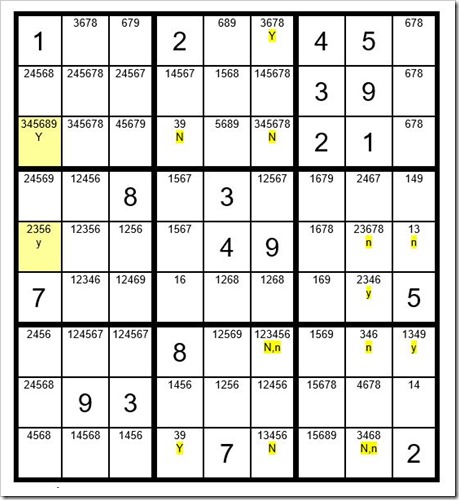
Example #30.4 |
Now your grid should look like Example #30.5 below.
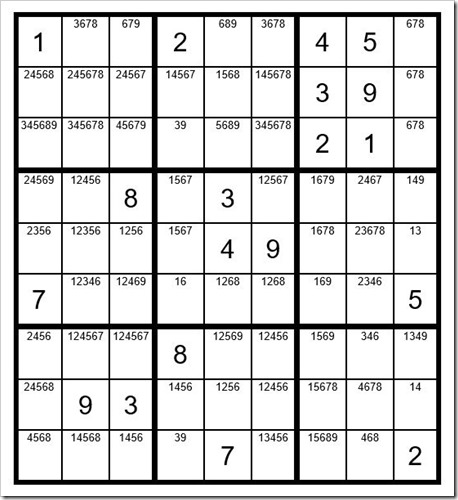
Example #30.5 |
Example #30.5
Eliminating the 3’s from those two cells yields no additional clues, so let’s keep marching ahead with Step 6.
As you can see below in Example #30.6 that there are just two unsolved cells in column 1 that contain a 9 as an option and are not in the same box, again meeting the criteria for a Step 6 exercise. These cells are highlighted in Example #30.6 below:
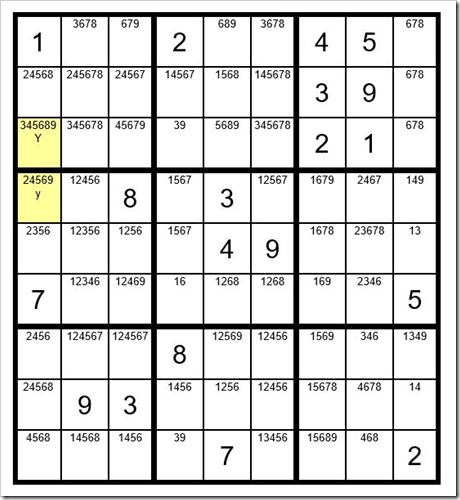
Example #30.6 |
If you will, please take your pencil and track the 9 from each of these 2 “starter cells”.
Your grid should now look like Example #30.7 below.
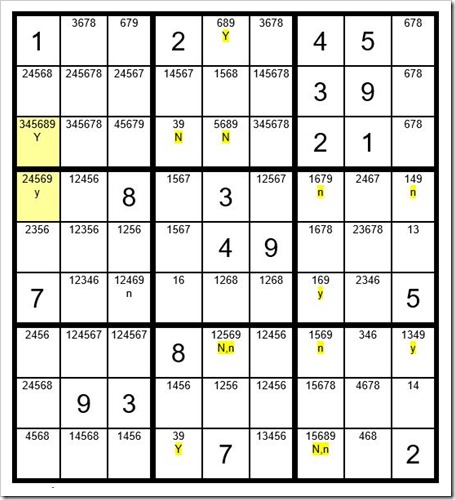
Example #30.7 |
Now we have proven that C5R7 & C7R9 cannot be a 9. Now your grid should look like Example #30.8 below:
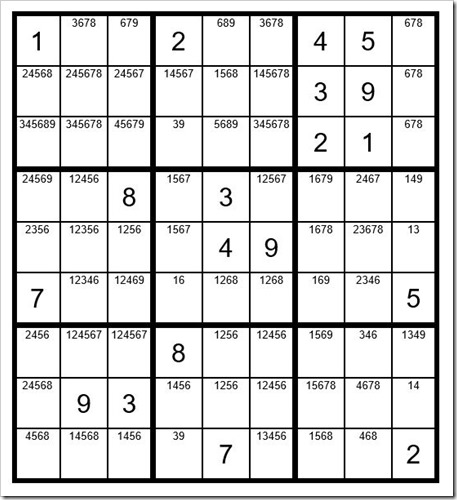
Example #30.8 |
Is this Step 6 a bit more helpful? Look carefully at row 9. How many unsolved cells have a 9 as an option? Right, just C4R9. You have solved this cell. C4R9=9 and then C4R3=3. Continuing … C2R1=3, C1R5=3, C9R5=1, C9R8=4. C9R4=9. Take it from here to solve all cells! Just remember, as you solve cells and thereby eliminate options from unsolved cells, be sure to process all obvious pairs.
Now your puzzle should look like Example #30.8 below:
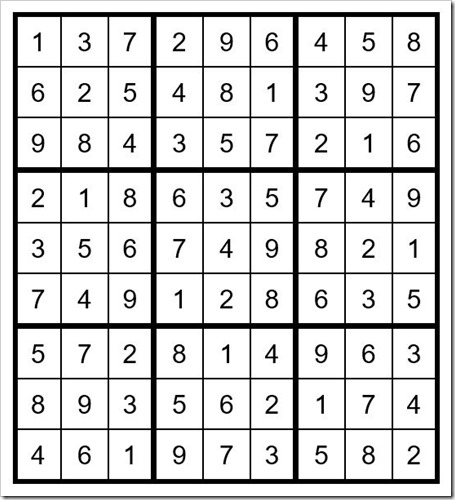
Example #30.9 |
In retrospect, we performed 2 Step 6 exercises. The first exercise resulted in minor impact in solving the puzzle. The 2nd Step 6 exercise was the key to “unlocking” a puzzle that looked very unsolvable.
Editor’s note:Do you tackle a Sudoku on your cottage veranda, sailboat cockpit, or at a campsite? TI Life is taking full advantage of Dan LeKander, from Wellesley Island, who is a Sudoku expert and author of “3 Advanced Sudoku Techniques – That Will Change Your Game Forever!”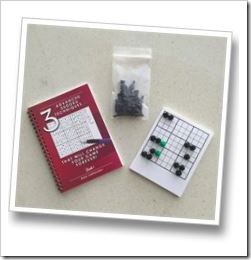 In January 2016, we published a final article in his original series – but many of us enjoy using “Dan’s Steps,” so when he asked if we would like a puzzle to solve every month … this editor said an enthusiastic… Yes, please! I suggest you try this difficult puzzle and that you also purchase Dan’s book, “3 Advanced Sudoku Techniques, That Will Change Your Game Forever!” Most importantly, I ask that you leave commentson any part of his series and throughout the year. Remember when your teacher said – no such thing as a silly question – as we can all learn together. Dan’s book is available online, amazon.com and on ebay.com. Purchase of a book includes a 50-page blank grid pad, 33 black and two green tokens, to assist with Step 6.… THANKS Dan and THANKS to your better half, Peggy LeKander, who helps make sure the article is correct and reads well. What a team! Please keep it up…. |
One of my favorite quotations is “The road to success is always under construction”. Online search gives credit for this quote to Lily Tomlin. May this Sudoku puzzle add to your Sudoku success in the future.
May the gentle winds of Sudoku be at your back.
Dan LeKander
Dan LeKander and his wife, Peggy, have been seasonal residents of Fineview, on Wellesley Island, NY, since 1983. In addition to being a Sudoku addict, Dan explores the 1000 Islands to enjoy the wildlife, beauty and of course, Catch-and Release bass fishing.
Editor’s Note: How many have your completed. I have the all stacked in a file, I will count the number I have completed. Will you?
[See Jessy Kahn’s Book Review, “3 Advanced Sudoku Techniques…” by Dan LeKander, June issue of TI Life.]